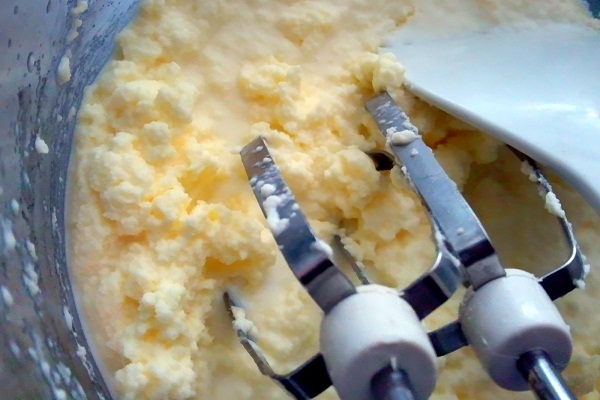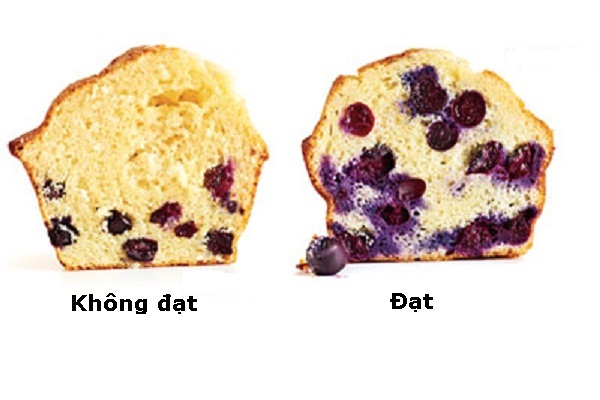The cake surface is swollen and cracked

The cake surface is swollen and cracked
Reason:
– The oven temperature is too high, causing the cake surface to cook quickly while the inside remains undercooked, leading to cracks on top.
– The cake mold should not be placed in the center of the oven.
How to fix:
– Follow the recipe instructions and preheat the oven to the specified temperature before putting in the cake.
– Use an oven thermometer to ensure the correct temperature.
– Always place the cake tray in the middle of the oven, unless otherwise specified in the recipe.
The dough mixture is lumpy

Uneven hand mixing causes the dough to clump
Reason:
– Ingredients should not be at room temperature before use.
– Butter and sugar are not whipped enough before adding eggs.
– Eggs are added too quickly.
– Uneven mixing.
How to fix:
– Bring the ingredients to room temperature before using.
– Whip butter and sugar adequately before adding eggs.
– Add eggs to the mixture slowly and gradually.
– Sift dry ingredients before mixing to prevent clumping.
Fresh cream is separated from water

Whipping cream (fresh cream) is easy to separate from water if beaten too carefully
Reason:
– Overbeating the cream causes it to separate from the water.
How to fix:
– Continue beating the cream until completely separated, then separate the cream and the water into two separate bowls. Beat the cream until stiff, and then slowly add back in the water while mixing gradually.
Uneven baking

Uneven baking makes the cake not spongy, not delicious
Reason:
– Flour is not evenly mixed into the batter.
– Oven temperature is too high.
– Overmixing the batter can break air bubbles and result in poor baking.
How to fix:
– Mix the flour thoroughly into the batter.
– Adjust the oven temperature as necessary.
– Use the correct sized baking pan and fill it to 2/3 full with batter.
Difficult to mix the dough

Failure to follow the mixing process, mixing ingredients indiscriminately can ruin the batch
Reason:
– Uneven ratio of ingredients.
– Incorrect mixing technique.
How to fix:
– Ensure correct measurements and ratios when mixing.
The cake has white dots (with sponge cake)

The cake has a number of white dots
Cause:
– Gelatinization of starches in the batter.
How to fix:
– Add sugar gradually and mix until dissolved before adding other ingredients.
Burnt cake – The core of the cake is dark and hard

The surface of the cake is burnt due to the oven temperature being too high
Reason:
– Oven temperature is too high.
How to fix:
– Check oven temperature and adjust as necessary.
– Use aluminum foil to cover the cake after it has partially baked to prevent further burning.
The surface of the cake is concave during baking

The surface of the cake is concave due to too much baking powder
Reason:
– Oven temperature is too low or too high.
– Overmixing the dough.
– Excess amount of baking powder.
How to fix:
– Avoid moving the cake during baking.
– Adjust oven temperature and monitor it closely.
– Measure ingredients accurately to prevent excessive baking powder.
Seeds or dried fruit sink to the bottom of the cake

The dried fruit is so heavy that it sinks to the bottom of the cake
Reason:
– Seeds or dried fruit are too big and heavy.
– Oven temperature is too low.
– Cake flour is not dense enough to hold the seeds.
How to fix:
– Coating the seeds with sugar or syrup can prevent sinking.
– Dusting the seeds with flour before mixing them with the cake flour can help them stay suspended in the batter.
The cake is too dry

Cake is dry due to too much baking powder and uneven mixing
Reason:
– Excessive flour or leavening agents.
– Insufficient fat or sugar.
– Overbaking or too high oven temperature.
How to fix:
– Check ingredient measurements and adjust as needed.
– Reduce baking time or oven temperature.































